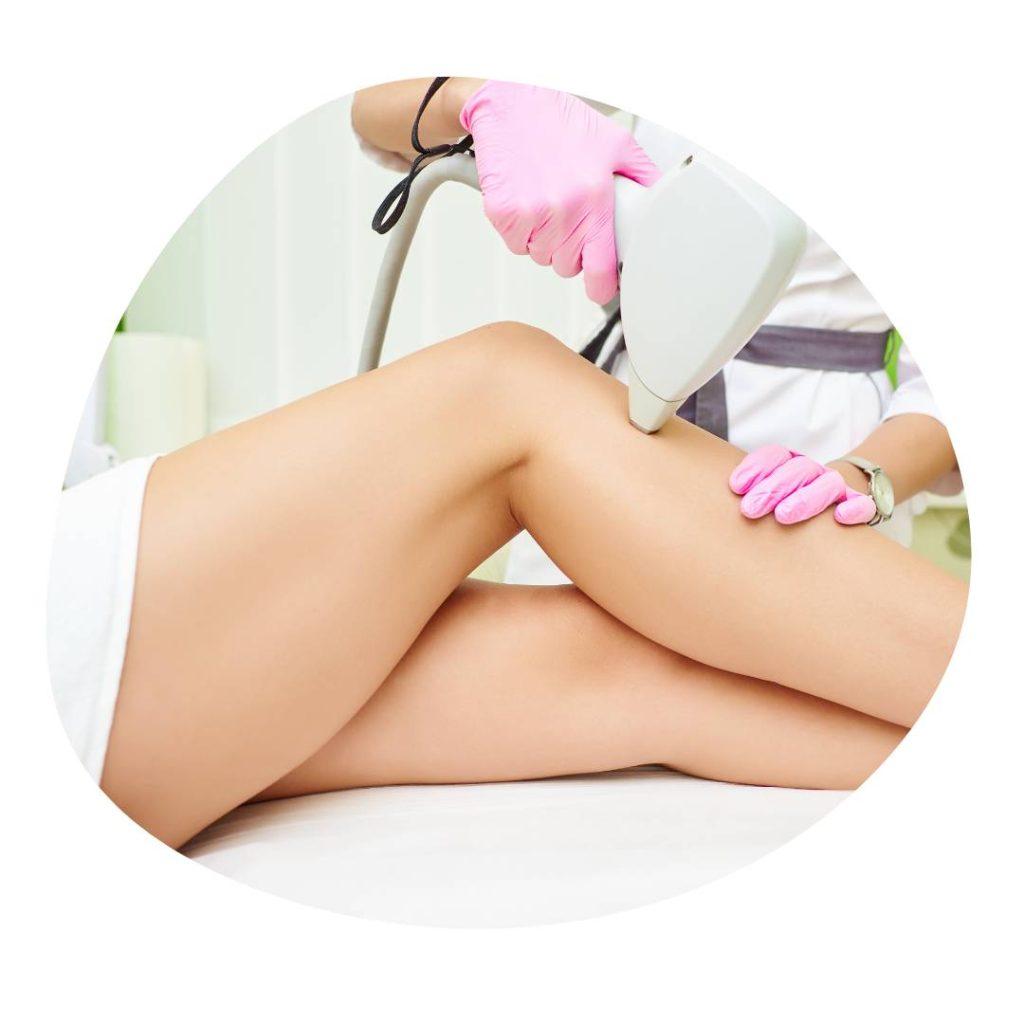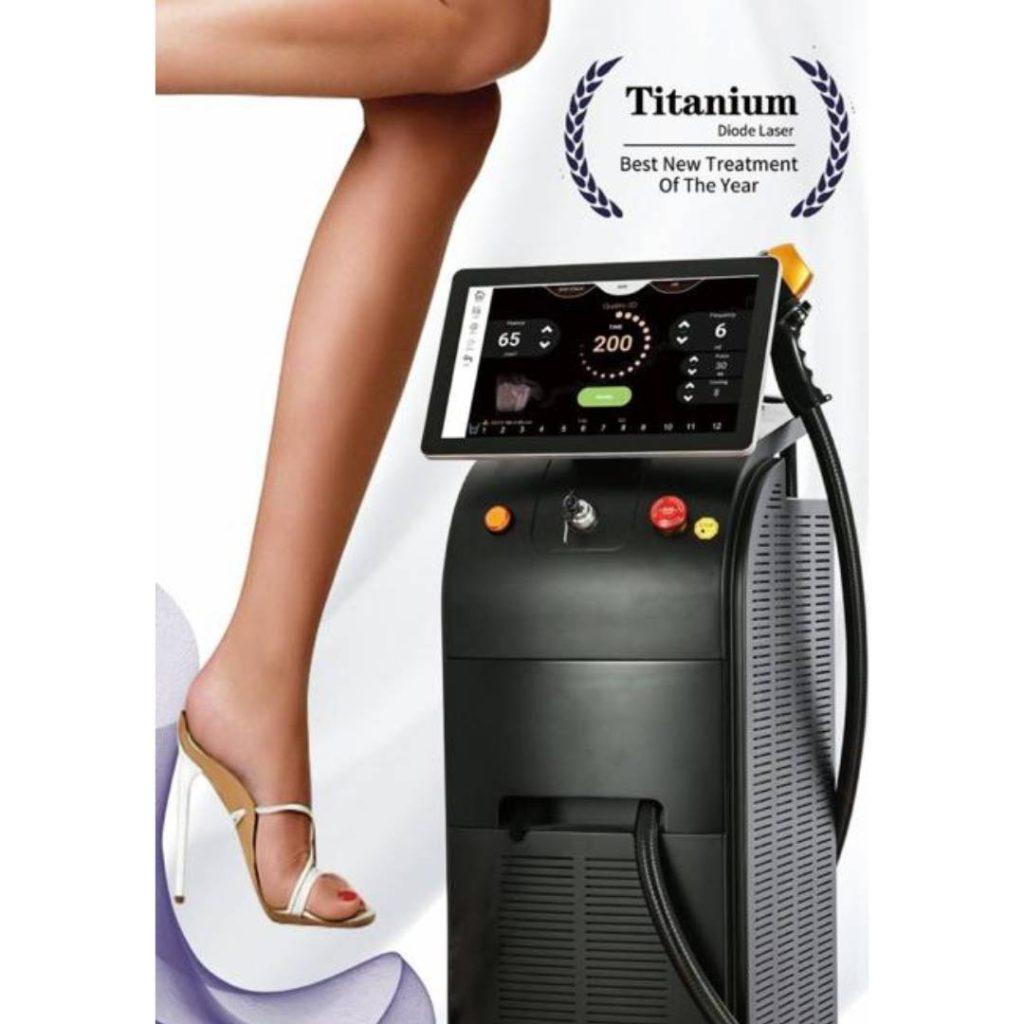Women Laser Hear Removal
What is Diode Laser Hair Removal?
Diode laser hair removal is a cosmetic procedure that uses a specific type of laser called a diode laser to target and remove unwanted body hair. It is a popular method for long-term hair reduction or removal.
During the procedure, a handheld device emitting a concentrated beam of light is used to target the hair follicles. The melanin pigment in the hair absorbs the laser energy, which damages the follicle and inhibits future hair growth. The surrounding skin and tissues are not significantly affected because the laser is designed to specifically target the darker pigment of the hair.
Diode laser hair removal is considered effective for most skin types and hair colors, although it works best on individuals with fair skin and dark, coarse hair. Multiple sessions are usually required to achieve optimal results because hair grows in cycles and the laser is most effective during the active growth phase.

The procedure is generally safe when performed by a trained professional, but there can be some temporary side effects such as redness, swelling, and mild discomfort in the treated area. It’s important to follow the post-treatment instructions provided by the technician to minimize any potential risks.
It’s worth noting that while diode laser hair removal can significantly reduce hair growth, it may not guarantee permanent hair removal. Some hair follicles can be resistant to the laser treatment or may regenerate over time, necessitating maintenance sessions to sustain the results.
Difference between Diode Laser Hair Removal and IPL:
Diode laser hair removal and Intense Pulsed Light (IPL) are both popular methods for hair removal, but they differ in terms of the technology used and how they target the hair follicles.
- Technology: Diode laser hair removal uses a single wavelength of laser light, typically in the range of 800-810 nanometers. This specific wavelength targets the melanin pigment in the hair follicles, effectively damaging them and inhibiting hair growth. IPL, on the other hand, uses a broad spectrum of light with multiple wavelengths, ranging from 500 to 1200 nanometers. IPL devices emit pulses of light rather than a focused laser beam.
- Precision: Diode lasers are more precise in targeting the hair follicles. The focused beam of light ensures that the energy is concentrated on the hair shaft and follicle, reducing the risk of damage to the surrounding skin. IPL devices, due to their broad spectrum of light, have a wider area of coverage and are less precise in targeting specific hair follicles. This makes diode lasers more suitable for precise and targeted hair removal, especially in smaller treatment areas.
- Effectiveness: Diode lasers are generally considered more effective for hair removal, especially for individuals with darker skin tones and coarse, dark hair. The specific wavelength of the diode laser is well-absorbed by the melanin in the hair follicles, providing effective hair reduction with fewer treatment sessions. IPL can also be effective for hair reduction, but it may require more treatments and may not be as effective for individuals with lighter hair colors or darker skin tones.
- Safety: Diode laser hair removal is considered safer for the skin because it specifically targets the hair follicles while minimizing damage to the surrounding tissues. IPL devices emit a broader spectrum of light, which can be absorbed by other pigments in the skin, potentially leading to more side effects such as burns, redness, and discoloration, particularly in individuals with darker skin.
When deciding between diode laser hair removal and IPL, it’s important to consider your skin type, hair color, and treatment goals. Consulting with a qualified professional can help determine the most suitable option for your specific needs.

Soprano Titanium Laser Hair Removal Machine:
The Soprano Titanium laser hair removal machine is a specific brand and model of laser hair removal device. It is an advanced system that incorporates diode laser technology for effective and comfortable hair removal.
The Soprano Titanium laser uses diode laser with wavelengths of 755, 808 and 1064 nanometers, suitable for all kind of skin types, which targets the melanin pigment in the hair follicles. These specific wavelengths ensure efficient absorption of the laser energy by the hair follicles while minimizing damage to the surrounding skin.
One of the notable features of the Soprano Titanium is its “IN-Motion” technology. This means that instead of delivering a single high-energy pulse, the laser is in constant motion and delivers a gradual build-up of heat to the targeted area. This allows for a more comfortable treatment experience with minimal discomfort.
The Soprano Titanium laser also incorporates a contact cooling system, which helps to cool the surface of the skin and further enhance patient comfort during the procedure. The cooling system helps protect the skin from excessive heat, reducing the risk of side effects.
Additionally, the Soprano Titanium laser is designed to be safe and effective for various skin types and hair colors, including darker skin tones. The device is equipped with adjustable parameters that can be customized to suit individual patient needs.
It’s important to note that while the Soprano Titanium laser can provide effective hair reduction, multiple treatment sessions are typically required to achieve optimal results. The number of sessions depends on factors such as the target area, hair density, and individual response to treatment.
Overall, the Soprano Titanium laser hair removal machine is known for its advanced technology, comfort, and safety features, making it a popular choice for both patients and practitioners seeking effective and comfortable laser hair removal treatments.
PRE-TREATMENT CARE
- The area to be treated must be clean-shaven.
- Avoid UV exposure 7 days prior to your treatment.
- Clients who are sunburned or tanned must wait 2 weeks before being treated to avoid additional skin damage.
- Avoid sunless tanning products 7 days prior to your treatment. It is recommended that you exfoliate the area to remove any residual color.
- If applicable, apply numbing cream 30 to 40 minutes prior to your treatment. All products must be completely removed prior to treatment.
- Clients should come to appointments with clean skin in the area to be treated. All clients who are treating any part of their face or neck will be required to cleanse their entire face in the clinic.
- Avoid chemical peels and other laser procedures in the area to be treated for 2 weeks prior and two weeks after your laser treatment.
- Avoid all alpha hydroxy and beta hydroxyl products (AHA/BHA), hydroquinone, retinols/retinoid, Tazorac, and Differin for 7 days before treatment.
- Clients with any abnormal lesions, moles or spots on the area to be treated must be cleared by a medical practitioner prior to treatment.
- Clients must stop waxing, tweezing and chemical epilation 3 weeks prior to treatment.
- If you are prone to cold sores, it is highly recommended to take an anti-viral medication (such as Valtrex) prior to your treatment. Clients with active cold sores will not be treated.
- Clients who have used Accutane or similar products within the last 6 months ( minimum) CANNOT have laser hair removal treatments.
- Client should not perform any physical activity that increases body temperature or blood pressure within 2 hours before and after treatments.
- If you have Botox or dermal fillers in the area to be treated, wait 14 days both before and after injection to receive treatments.
- Antibiotics may increase photosensitivity. We recommend that you check with your personal physician prior to receiving laser treatments if you are taking a long-term antibiotic. If you become ill and begin taking an antibiotic, you will need to be off the medication for 7 days ( minimum, sometimes 2-3 weeks) before laser treatment.
WHAT TO EXPECT FROM YOUR TREATMENT
- Clients with red, grey or blonde hair in the area to be treated should consult with a Simplicity Laser Technician prior to receiving treatments, as the laser is less effective on these hair colors.
- During your treatment clients can expect slight discomfort, similar to a rubber-band snap on your skin. An over the counter numbing cream is available for purchase.
- Clients may experience slight redness, bumps, and swelling in the treated area for up to 72 hours. If these conditions persist, topical creams such as Restorative Gel (highest recommended), aloe, calamine, polisporin or hydrocortisone may be applied.
- Allow a minimum of 7 to 14 days post treatment for hair to “fall out” or shed from the skin.
- On average, clients experience up to 30% reduction after each treatment.
POST-TREATMENT CARE
- Avoid extended UV exposure for 7 days post-treatment.
- Tylenol is recommended for post-treatment discomfort.
- Over the counter medication is recommended for post treatment discomfort. You may also apply Restorative Gel (highest recommended), cool towels, ice packs or aloe vera to alleviate discomfort due to heat.
- Avoid using seat warmers immediately after treatment.
- Avoid any additional laser treatments or chemical procedures on the treated area for at least 2 weeks post-treatment or until healing has occurred.
- Using a broad spectrum UVA/UVB SPF 40 or higher is critical when receiving laser treatments and is recommended ongoing for maintenance.
- If a client experiences any side effects, such as hypo- or hyper-pigmentation, prolonged redness or swelling, a histamine reaction, or blistering, call or come in for instructions on treatment.
- To achieve the best results, complete the full treatment schedule at the intervals recommended by your technician.
- Exfoliate treated areas to minimize risk of ingrown hairs.


